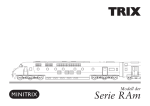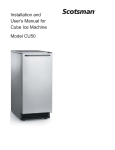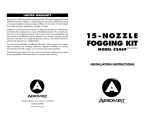Download Excerpts of Manual Plumbing System
Transcript
PLUMBING SYSTEM OWNER’S MANUAL | 5. Plumbing System Water Heater Dependant upon the model installed, the water heater can be gas, gas/electric or electric. For specific water heater instructions, please consult the Owner’s Manual provided by the manufacturer. Make sure that the water heater is filled before attempting to light or heat by electricity, otherwise the heating element will be damaged. Care and Maintenance Proper maintenance of the water heater relies on inspection and awareness. (Full maintenance requirements are listed within the manufacturer’s user’s manual.) A qualified technician should do any repairs that are required. On gas water heaters, if soot is present anywhere, immediately shut down the unit and contact a qualified service technician. Soot is a sign of incomplete combustion and must be corrected before operating the water heater. Pressure Relief Valve – Weeping or Dripping The water heater is equipped with a relief valve designed to open when the water temperature is too high or excessive pressure has built up. In these circumstances the relief valve will open and water will drip from the valve. The valve will close automatically once the situation corrects itself. If dripping is continuous it would indicate a malfunctioning or defective valve. Draining for Non-Use or Winterization When not using the water heater for long periods ot time, or storing for the winter months, it must be drained to avoid deterioration from mineral content in the water supply or freezing. To drain the tank, please follow these guidelines. To drain the tank: • Turn the power off to the water heater at the switch or the main breaker. Warning: draining the water heater with the power on will damage the water heater. • Shut off the gas supply. • Open all fixtures, both hot and cold throughout the unit. • If equipped, turn the valve on the water heater by-pass kit to the by-pass position. (see addition sheet on water heater by-pass operation) • If equipped with an RV style water heater; remove/open the water heater door on the outside of the unit and remove the anode rod from the tank. The water will drain out of the tank. Consult the owner’s manual for details and be sure to allow the water to have cooled off first to avoid injury. • For water heaters not equipped with an exterior door or anode tube, a garden hose must be attached to the drain valve located at the bottom of the water heater. Avoid damage to the interior of the unit from leaking water. Water Heater By-Pass Kit 14 PLUMBING SYSTEM OWNER’S MANUAL | Serious water heater damage can result from a lack of winterizing maintenance. Ensure electric power is turned off to avoid element burn out. Consult your water heater literature or a qualified maintenance person for complete details beyond valve settings described here. Diagram # 1: Normal Operation (also for blowing out lines with compressed air for preparation to winterize) Valve #1 (hot water outlet) to be fully open. Valve #3 (cold water inlet) to be fully open. Valve #2 (by-pass link) closed to restrict flow. Arrows show direction of water flow. Shaded areas indicate pipes not in use. Diagram # 2: winterizing procedure & the addition of potable non-toxic antifreeze Valve #1 (hot water outlet) to be closed. Valve #3 (cold water inlet) to be closed. Valve #2 (bypass link) fully opened. When lines are filled with antifreeze, slightly open valve #1 to allow some antifreeze into the water heater, then close valve #1 fully. Arrows show direction of water flow. Shaded areas indicate pipes not in use. Note: When preparing to use unit in spring, completely flush lines and water heater to discharge antifreeze fluids. This unit is not manufactured to be a place of permanent residence. It is intended for recreational use to be occupied on a non-permanent basis. Please refer to conditions of warranty coverage which will be limited if any issues arise during use in the winter season. 15 PLUMBING SYSTEM OWNER’S MANUAL | Winterization Information This represents a general winterization procedure. Protecting the plumbing system and its related components from freezing is crucial. Damages due to weather are not covered under Northlander’s warranty policy at any time. Please refer to the owner’s manual of the appliances for further information. It is recommended that a qualified experienced technician is used to winterize the unit but many owners choose to do this themselves. Water Heater The water heater installed in the unit will either be gas, gas/electric, or electric. For specific instructions please consult the owner’s manual provided in the information envelope included with the unit. When not using the water heater for long periods of time, or for storing in the winter months, it must be drained to avoid deterioration from mineral content in the water supply or freezing. To drain the tank, please follow these guidelines… • Turn the power off to the water heater at the switch or the main breaker. Warning: draining the water heater with the power on will damage the water heater. • Shut off the gas supply. • Open all fixtures, both hot and cold throughout the unit. • If equipped, turn the valve on the water heater by-pass kit to the by-pass position. (see addition sheet on water heater by-pass operation) • If equipped with an RV style water heater; remove/open the water heater door on the outside of the unit and remove the anode rod from the tank. The water will drain out of the tank. Consult the owner’s manual for details and be sure to allow the water to have cooled off first to avoid injury. • For water heaters not equipped with an exterior door or anode tube, a garden hose must be attached to the drain valve located at the bottom of the water heater. Avoid damage to the interior of the unit from leaking water. Water lines Although not necessary some customers may choose to have non-toxic anti-freeze put into their water lines for additional protection. If the lines are blown out properly, there is technically no need to have any additive in the water lines. • Turn the power off to the water heater at the switch or the main breaker. • Turn the fuel supply off to the water heater. • Turn the water supply off to the unit. • If equipped, turn the valve on the water heater by-pass to the by-pass position. (see addition sheet on water heater by-pass operation) • Drain the water heater. (See instructions on page 1 of winterizing information.) • If installed, remove the water filter from the assembly and discard. Install diverter if included. • Open all fixtures, both hot and cold throughout the unit including the shower head sprayer, toilet flushing devise and any other closed water line. • Remove the water from the toilet bowl and tank. • Attach an air hose to the unit at the water inlet using a connecting adapter. • With the air pressure set no greater than 30 PSI, blow out the water lines until there is no more water coming out of the fixtures and water lines. • Prop up the float valve in the toilet tank to close the water supply to the tank. • Pour RV anti-freeze into all the sink drains so there is enough to protect the ‘p’ traps. Be sure to include the toilet bowl and pour some into the bottom of the toilet tank as well. 16








